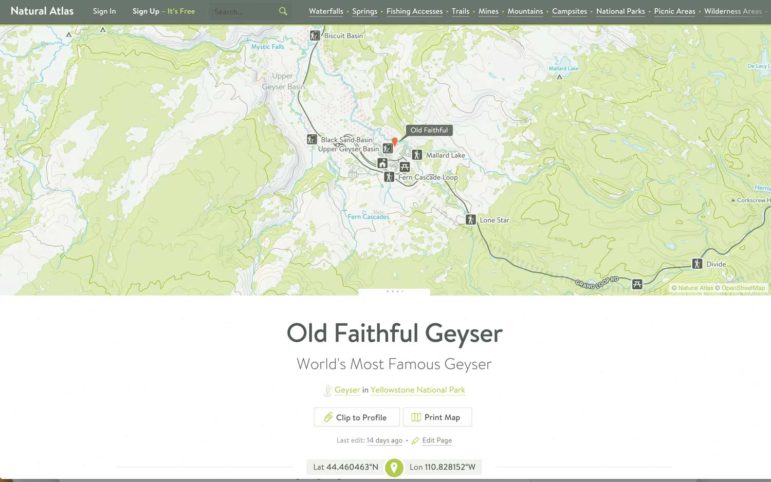
Visitors to the greater Yellowstone area can use any number of apps, websites and other digital tools to find a great hotel or restaurant, relying on reviews and tips from locals and other tourists to decide which one is right for them. A few more clicks can yield turn-by-turn directions and detailed street maps.
But what about the great outdoors? Wouldn’t it be great if you could search through detailed topographical maps for natural features the same way you use Google maps to find a coffee shop? Or what if your fellow hikers, anglers, climbers and others could add comments and photos to points of interest like waterfalls or campgrounds—with all of that data easily found through a quick online search?
It seems like an impossible fantasy for outdoor enthusiasts, but Natural Atlas is a newly launched online platform that aims to accomplish all that and more. The site’s initial focus is on Yellowstone National Park and the surrounding region, including Montana, Idaho and Wyoming.
“There are a lot of problems we’re trying to solve with this,” said Brian Reavis, who co-founded Natural Atlas with brother Brandon Reavis. “We came up with it after being frustrated with the state of outdoor maps. We wanted to build something that’s the merger of a good map with a comprehensive online guide about everything on the map.”
The Reavis brothers grew up in Cody, Wyo., and are intimately familiar as only locals can be with many of Yellowstone country’s most visited rivers, geysers, climbing areas and other favorite spots. Their site is built so that locals and frequent visitors can share that detailed knowledge with first-timers.
For the past year, the brothers have been working full-time to develop the site, which launched in June. Brandon has been compiling map data from a host of government agencies, while Brian has been building out the website.
The result so far is a wildly ambitious platform that is a blend of some of the best features from the most popular sites on the Internet.
- Topographical maps show detailed hiking trails and four-wheeler routes, like a Google maps for the backcountry.
- User-submitted photos offer a first-hand look at natural features, like a Flickr feed for wild places.
- Anyone can submit or edit a page about a point of interest, like a Wikipedia of the great outdoors.
- And users can save to their personal accounts all of their favorite spots, even adding short notations, creating a Pinterest-style curated set of open spaces.
With no marketing or promotion, and working far from hotbeds of digital development like Silicon Valley or Los Angeles, the site is already building a following.
“The response so far has been really positive,” Brian Reavis said. “We’ve had some good press, and there were more than 1,000 people who signed up for accounts in the first week.”
Some national online sites like LifeHacker.com have featured Natural Atlas, and Outside magazine is working on a feature about the site, he said.
The biggest challenge so far has been reconciling inconsistent mapping data from various land management agencies, Reavis said. That has required writing custom code, as has much of how the website functions. While public domain maps have been compiled from government agencies and some open source street map data has been used, the brothers have also personally created several entries on specific points of interest.
The site already lists more than a million natural features across the tri-state region, divided into more than 250 categories, including: mines, streams, mountain passes, fossils, fishing access, rock formations, caves, glaciers and more.
Their efforts so far have been self-funded, and the goal is to make the site free and accessible to anyone. But the initial plan for generating revenue involves charging a $30 annual fee that will allow upgraded users to print maps for offline use and export detailed map data to popular handheld GPS units.
Selling sponsored placements on the site for local gear shops or other relevant businesses may also be an option, Reavis said. But he wants to avoid cluttering the site—and its maps—with busy banner ads.
And if Natural Atlas didn’t already sound like a bit much for two people to tackle, Reavis said they will expand coverage within a few weeks to include Colorado, and eventually plan to cover the entire United States.
But the over-riding goal is to keep the individual, local user focused on finding and sharing the kinds of small details they know best.
“Having local people add information about the best place to cross a stream or find wild strawberries is the kind of really neat information that can make a backpacking trip awesome,” Reavis said. “And that kind of thing is only going to come from someone who is out hiking the trail.”
Contact Ruffin Prevost at 307-213-9818 or [email protected].
